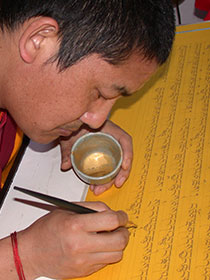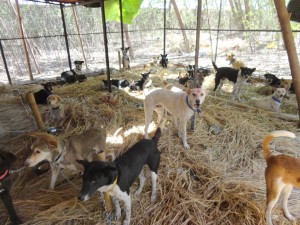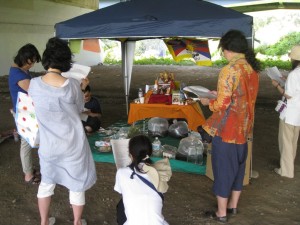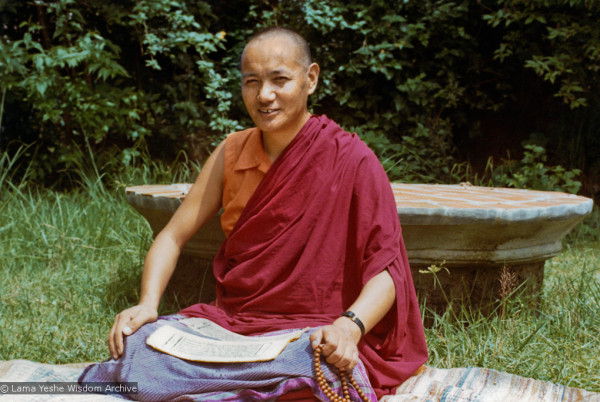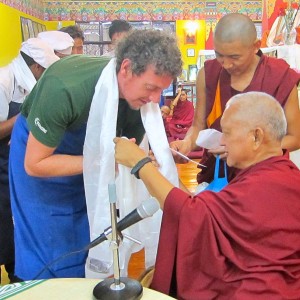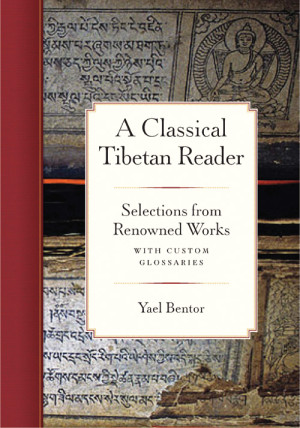- Home
- FPMT Homepage
Foundation for the Preservation of the Mahayana Tradition
The FPMT is an organization devoted to preserving and spreading Mahayana Buddhism worldwide by creating opportunities to listen, reflect, meditate, practice and actualize the unmistaken teachings of the Buddha and based on that experience spreading the Dharma to sentient beings. We provide integrated education through which people’s minds and hearts can be transformed into their highest potential for the benefit of others, inspired by an attitude of universal responsibility and service. We are committed to creating harmonious environments and helping all beings develop their full potential of infinite wisdom and compassion. Our organization is based on the Buddhist tradition of Lama Tsongkhapa of Tibet as taught to us by our founders Lama Thubten Yeshe and Lama Thubten Zopa Rinpoche.
- Willkommen
Die Stiftung zur Erhaltung der Mahayana Tradition (FPMT) ist eine Organisation, die sich weltweit für die Erhaltung und Verbreitung des Mahayana-Buddhismus einsetzt, indem sie Möglichkeiten schafft, den makellosen Lehren des Buddha zuzuhören, über sie zur reflektieren und zu meditieren und auf der Grundlage dieser Erfahrung das Dharma unter den Lebewesen zu verbreiten.
Wir bieten integrierte Schulungswege an, durch denen der Geist und das Herz der Menschen in ihr höchstes Potential verwandelt werden zum Wohl der anderen – inspiriert durch eine Haltung der universellen Verantwortung und dem Wunsch zu dienen. Wir haben uns verpflichtet, harmonische Umgebungen zu schaffen und allen Wesen zu helfen, ihr volles Potenzial unendlicher Weisheit und grenzenlosen Mitgefühls zu verwirklichen.
Unsere Organisation basiert auf der buddhistischen Tradition von Lama Tsongkhapa von Tibet, so wie sie uns von unseren Gründern Lama Thubten Yeshe und Lama Thubten Zopa Rinpoche gelehrt wird.
- Bienvenidos
La Fundación para la preservación de la tradición Mahayana (FPMT) es una organización que se dedica a preservar y difundir el budismo Mahayana en todo el mundo, creando oportunidades para escuchar, reflexionar, meditar, practicar y actualizar las enseñanzas inconfundibles de Buda y en base a esa experiencia difundir el Dharma a los seres.
Proporcionamos una educación integrada a través de la cual las mentes y los corazones de las personas se pueden transformar en su mayor potencial para el beneficio de los demás, inspirados por una actitud de responsabilidad y servicio universales. Estamos comprometidos a crear ambientes armoniosos y ayudar a todos los seres a desarrollar todo su potencial de infinita sabiduría y compasión.
Nuestra organización se basa en la tradición budista de Lama Tsongkhapa del Tíbet como nos lo enseñaron nuestros fundadores Lama Thubten Yeshe y Lama Zopa Rinpoche.
A continuación puede ver una lista de los centros y sus páginas web en su lengua preferida.
- Bienvenue
L’organisation de la FPMT a pour vocation la préservation et la diffusion du bouddhisme du mahayana dans le monde entier. Elle offre l’opportunité d’écouter, de réfléchir, de méditer, de pratiquer et de réaliser les enseignements excellents du Bouddha, pour ensuite transmettre le Dharma à tous les êtres. Nous proposons une formation intégrée grâce à laquelle le cœur et l’esprit de chacun peuvent accomplir leur potentiel le plus élevé pour le bien d’autrui, inspirés par le sens du service et une responsabilité universelle. Nous nous engageons à créer un environnement harmonieux et à aider tous les êtres à épanouir leur potentiel illimité de compassion et de sagesse. Notre organisation s’appuie sur la tradition guéloukpa de Lama Tsongkhapa du Tibet, telle qu’elle a été enseignée par nos fondateurs Lama Thoubtèn Yéshé et Lama Zopa Rinpoché.
Visitez le site de notre Editions Mahayana pour les traductions, conseils et nouvelles du Bureau international en français.
Voici une liste de centres et de leurs sites dans votre langue préférée
- Benvenuto
L’FPMT è un organizzazione il cui scopo è preservare e diffondere il Buddhismo Mahayana nel mondo, creando occasioni di ascolto, riflessione, meditazione e pratica dei perfetti insegnamenti del Buddha, al fine di attualizzare e diffondere il Dharma fra tutti gli esseri senzienti.
Offriamo un’educazione integrata, che può trasformare la mente e i cuori delle persone nel loro massimo potenziale, per il beneficio di tutti gli esseri, ispirati da un’attitudine di responsabilità universale e di servizio.
Il nostro obiettivo è quello di creare contesti armoniosi e aiutare tutti gli esseri a sviluppare in modo completo le proprie potenzialità di infinita saggezza e compassione.
La nostra organizzazione si basa sulla tradizione buddhista di Lama Tsongkhapa del Tibet, così come ci è stata insegnata dai nostri fondatori Lama Thubten Yeshe e Lama Zopa Rinpoche.
Di seguito potete trovare un elenco dei centri e dei loro siti nella lingua da voi prescelta.
- 欢迎 / 歡迎
简体中文
“护持大乘法脉基金会”( 英文简称:FPMT。全名:Foundation for the Preservation of the Mahayana Tradition) 是一个致力于护持和弘扬大乘佛法的国际佛教组织。我们提供听闻,思维,禅修,修行和实证佛陀无误教法的机会,以便让一切众生都能够享受佛法的指引和滋润。
我们全力创造和谐融洽的环境, 为人们提供解行并重的完整佛法教育,以便启发内在的环宇悲心及责任心,并开发内心所蕴藏的巨大潜能 — 无限的智慧与悲心 — 以便利益和服务一切有情。
FPMT的创办人是图腾耶喜喇嘛和喇嘛梭巴仁波切。我们所修习的是由两位上师所教导的,西藏喀巴大师的佛法传承。
繁體中文
護持大乘法脈基金會”( 英文簡稱:FPMT。全名:Found
ation for the Preservation of the Mahayana Tradition ) 是一個致力於護持和弘揚大乘佛法的國際佛教組織。我們提供聽聞, 思維,禪修,修行和實證佛陀無誤教法的機會,以便讓一切眾生都能 夠享受佛法的指引和滋潤。 我們全力創造和諧融洽的環境,
為人們提供解行並重的完整佛法教育,以便啟發內在的環宇悲心及責 任心,並開發內心所蘊藏的巨大潛能 — 無限的智慧與悲心 – – 以便利益和服務一切有情。 FPMT的創辦人是圖騰耶喜喇嘛和喇嘛梭巴仁波切。
我們所修習的是由兩位上師所教導的,西藏喀巴大師的佛法傳承。 察看道场信息:
- FPMT Homepage
- News/Media
-
- Study & Practice
-
-
- About FPMT Education Services
- Latest News
- Programs
- New to Buddhism?
- Buddhist Mind Science: Activating Your Potential
- Heart Advice for Death and Dying
- Discovering Buddhism
- Living in the Path
- Exploring Buddhism
- FPMT Basic Program
- FPMT Masters Program
- FPMT In-Depth Meditation Training
- Maitripa College
- Lotsawa Rinchen Zangpo Translator Program
- Universal Education for Compassion & Wisdom
- Online Learning Center
-
- Prayers & Practice Materials
- Overview of Prayers & Practices
- Full Catalogue of Prayers & Practice Materials
- Explore Popular Topics
- Benefiting Animals
- Chenrezig Resources
- Death & Dying Resources
- Lama Chopa (Guru Puja)
- Lama Zopa Rinpoche: Compendium of Precious Instructions
- Lama Zopa Rinpoche: Life Practice Advice
- Lama Zopa Rinpoche Practice Series
- Lamrim Resources
- Mantras
- Prayer Book Updates
- Purification Practices
- Sutras
- Thought Transformation (Lojong)
- Audio Materials
- Dharma Dates - Tibetan Calendar
- Translation Services
- Publishing Services
- Ways to Offer Support
- Prayers & Practice Materials
-
- Teachings and Advice
- Find Teachings and Advice
- Lama Zopa Rinpoche Advice Page
- Lama Zopa Rinpoche: Compendium of Precious Instructions
- Lama Zopa Rinpoche Video Teachings
- ༧སྐྱབས་རྗེ་བཟོད་པ་རིན་པོ་ཆེ་མཆོག་ནས་སྩལ་བའི་བཀའ་སློབ་བརྙན་འཕྲིན།
- Podcasts
- Lama Yeshe Wisdom Archive
- Buddhism FAQ
- Dharma for Young People
- Resources on Holy Objects
- Teachings and Advice
-
-
*If a menu item has a submenu clicking once will expand the menu clicking twice will open the page.
-
-
- Centers
-
- Teachers
-
- Projects
-
-
-
-
*If a menu item has a submenu clicking once will expand the menu clicking twice will open the page.
-
-
- FPMT
-
-
-
-
-
Without the practice of morality, there’s no enlightenment, no liberation from samsara, not even good rebirths in future lives.
Lama Zopa Rinpoche
-
-
-
- Shop
-
-
-
The Foundation Store is FPMT’s online shop and features a vast selection of Buddhist study and practice materials written or recommended by our lineage gurus. These items include homestudy programs, prayers and practices in PDF or eBook format, materials for children, and other resources to support practitioners.
Items displayed in the shop are made available for Dharma practice and educational purposes, and never for the purpose of profiting from their sale. Please read FPMT Foundation Store Policy Regarding Dharma Items for more information.
-
-
Mandala
19
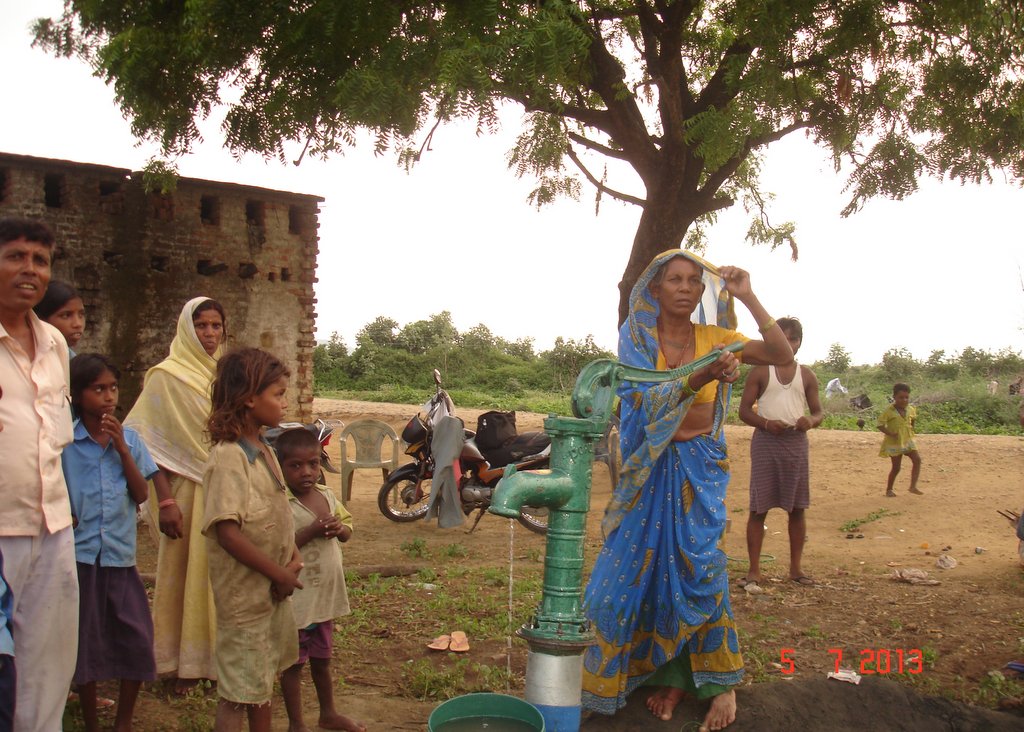
Villagers of Nimi finally have water as a result of MATRI’s work, Fatehpur, India, July 2013. Photo courtesy of MAITRI.
From Adriana Ferranti, director of MAITRI Charitable Trust
Since February, MAITRI Charitable Trust, an FPMT-affiliated project in Bodhgaya, India, has been carrying out sterilizations of street dogs from Bodhgaya with a major three-week camp and two smaller ones. We’ve seen 395 dogs that have been sterilized, vaccinated against rabies and released to their territories after full recovery. We seem to be catching many “latest-generation” dogs. Amazing how many have managed to escape our drives and how many puppies have managed to survive.
In April, we finalized the results of the end-of-year test in our three village schools. Since only pupils with regular attendance were admitted, 326 took the exam in all six grades in both formal and non-formal classes and 108 were promoted. The new school year started with 547 pupils, inclusive of promoted, failed and newly registered children.
In May, we organized and paid for a deep boring tube-well and hand pump in the extremely undeveloped and destitute village of Nimi in Fatehpur province. There are hundreds of such villages in the district, which somehow fall in the blind spot of the government services that are supposed to provide hand pumps to all villages.
The blasts of July 7 in and around the Mahabodhi Temple have marked a fault-line in Bodhgaya. Gone are the shops and hawkers that crowded, littered and polluted with unbearable noise the space outside the temple, but in have come armed guards and detectors of various kinds that are certainly at odds with the seat of enlightenment. But finally the International Buddhist Council has found some common cause to pray for besides electricity bills, taxes and so forth – every week we meet to pray for peace.
MAITRI Charitable Trust does humanitarian work in Bihar, one of India’s poorest and most densely populated states, providing programs addressing the needs of people in the areas health, nutrition and education as well as care for animals.
Mandala brings you news of FPMT activities, teachers and events from more than 160 FPMT centers, projects and services around the globe. If you have news you would like to share, please let us know.
- Tagged: animals, bodhgaya, maitri charitable trust, mandala
- 0
16
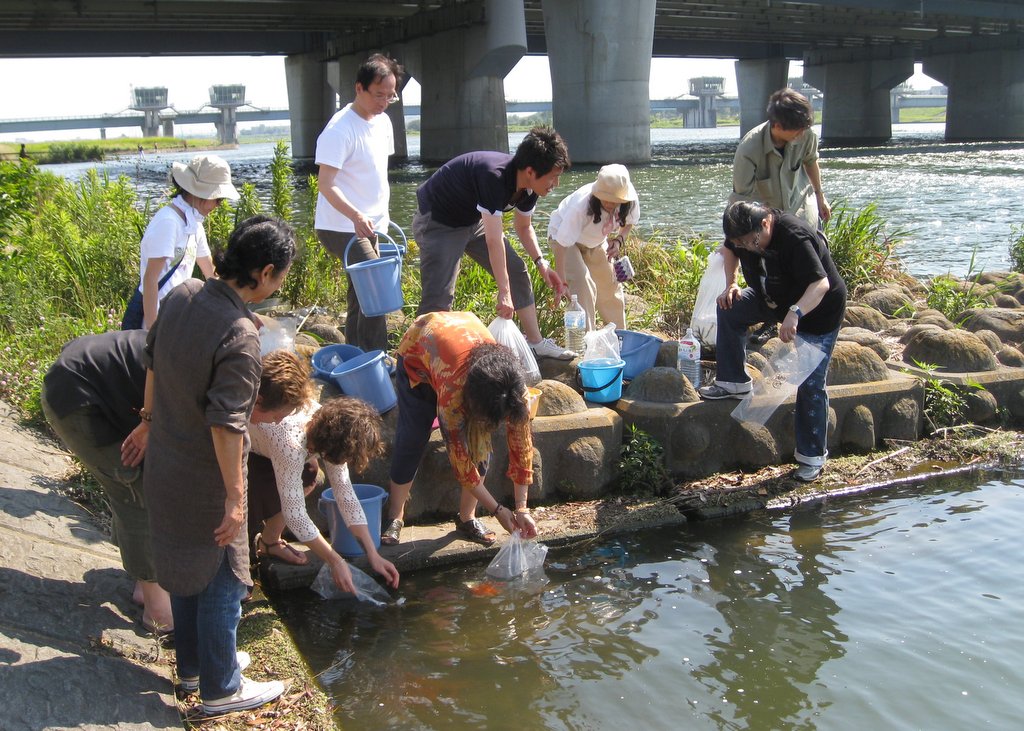
DNSJ students liberating fish, Tokyo, July 2013. Photo courtesy of Doc O’Connor.
From Doc O’Connor, director Do Ngak Sung Juk Centre
One of the many benefits of a being a small center in a large organization is joining with our global friends in activities to increase blessings. Do Ngak Sung Juk Centre (DNSJ) in Tokyo participated in FPMT North America’s Compassion Day on His Holiness the Dalai Lama’s birthday.
It was perfect timing for our annual animal liberation. Fifteen participants and 1,000-plus animals survived that day’s sweltering heat and humidity. The small fish weren’t the only ones wanting to jump in the river! Our activity was also dedicated to our most kind and generous Lama Zopa Rinpoche’s long life.
We appreciate centers including DNSJ in their activities and we’d like to invite everyone, especially our Asian friends, to DNSJ’s nyung nä! The intense three-day practice is scheduled for September 20-23 in Mitake, north Tokyo, at a mountain shrine that’s been in existence for almost 2,000 years. Ven. Thubten Dechen, the multilingual translator from Heruka Center in Taiwan, will lead the practice. Visit our website for more information.
Mandala rejoices in the practices of dedicated FPMT students from the more than 160 FPMT centers, projects and services around the world and seeks to shares their stories of beneficial activities. If you have news you would like to share, please let us know.
- Tagged: animals, compassion day, do ngak sung juk centre, mandala, rejoice
- 0
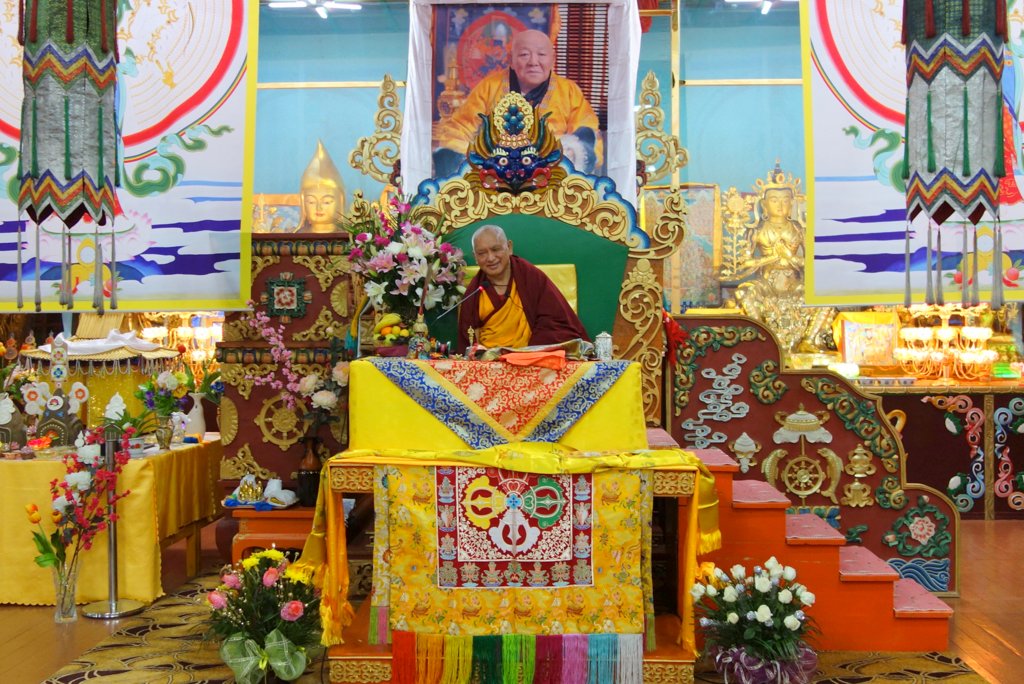
Lama Zopa Rinpoche at 100 Million Mani Retreat, Mongolia, August 15, 2013. Photo by Ven. Roger Kunsang.
On the morning of August 15, Lama Zopa Rinpoche joined the 100 Million Mani Retreat currently taking place in Ulaanbaatar, Mongolia. FPMT Mongolia organized the retreat, which is being held at Idgaa Choizinling Dratsang (College), Gandan Monastery.
The retreat began on August 1. Rinpoche’s arrival in Mongolia was delayed due to his private retreat in Lahaul-Spiti district of Himachal Pradesh taking longer than originally planned. Rinpoche also stopped at Kopan Monastery in Nepal on this way from India to Mongolia.

Participants of 100 Million Mani Retreat, Mongolia, August 2013. Photo courtesy of FPMT Mongolia’s Facebook page.
Mandala brings you news of Lama Zopa Rinpoche and FPMT activities, teachers and events from over 160 FPMT centers, projects and services around the globe. If you have news you would like to share, please let us know.
14
1974: ‘The Biggest Buddha, Dear’
In 1974, FPMT founders Lama Yeshe and Lama Zopa Rinpoche were continuing to teach Kopan meditation courses at the request of their Western students. The courses, which are still offered annually, exposed students to their unique and experiential understanding of lam-rim. It also gave attendees the opportunity to see the special relationship Lama and Rinpoche had as guru and disciple.
Adele Hulse records some of the stories of the 1974 Kopan courses in Big Love, the forthcoming biography of FPMT founder Lama Yeshe. Lama Yeshe Wisdom Archive will publish Big Love later this year and has been sharing excerpts from the book on their Big Love blog. The following is from a recent post:
One day when one of the course participants was speaking with Lama Yeshe in his room, Lama Zopa came in, fell to his knees, and started to pray. For the benefit of that student Lama pointed toward himself and said, “Dorje Chang,” indicating that Rinpoche was seeing him in the aspect of Dorje Chang. (“Who is Dorje Chang?” a student once asked him. “The biggest buddha, dear,” Lama replied.) Some students reported that they had seen Rinpoche making offerings to Lama Yeshe with tears running down his face. At other times he would not raise his eyes to look at Lama at all. Lama Yeshe was often heard speaking brusquely to Rinpoche; at the same time he also told students that Rinpoche was one of the most highly evolved beings on this planet. Lama Yeshe addressed Lama Zopa as “Kusho.” This term is generally translated from the Tibetan as “your honor” or “your worship,” and is how Tibetans commonly address monks and others of higher rank in society. These translations, however, in no way capture the clear warmth and affection expressed when Lama Yeshe addressed Rinpoche in that way. Lama actually told one student that compared to Rinpoche, he himself was just a water buffalo. And late at night, when the two lamas were alone together, all that students ever heard was an indescribable cascade of their laughter pouring out across the hill, like two buddhas in total bliss.
Read the entire post by Adele Hulse on the Big Love blog.
- Tagged: adele hulse, big love, kopan course, mandala
- 0
13
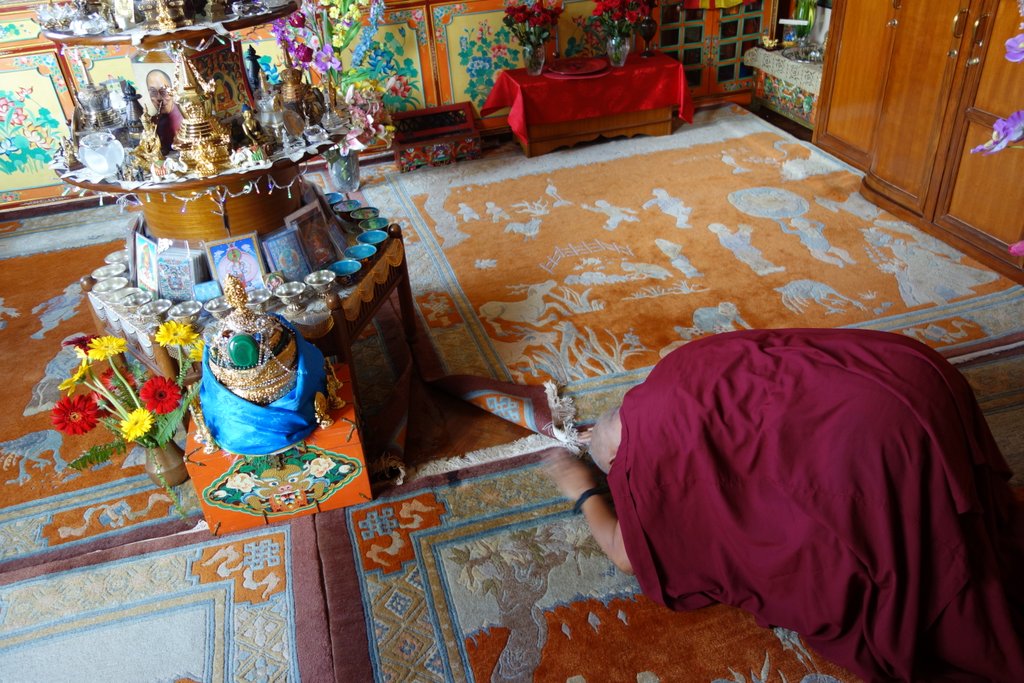
Lama Zopa Rinpoche making prostrations to his altar at Kopan Monastery, August 10, 2013. Photo by Ven. Roger Kunsang.
“First thing in the morning, Lama Zopa Rinpoche is doing prostrations to the altar in his room,” Ven. Roger Kunsang, Rinpoche’s assistant wrote on August 10 from Kopan Monastery in Nepal. “There is one altar that has many holy relics on it and Rinpoche circumambulates it every day. Rinpoche is making a very quick stop here on the way to Mongolia.”
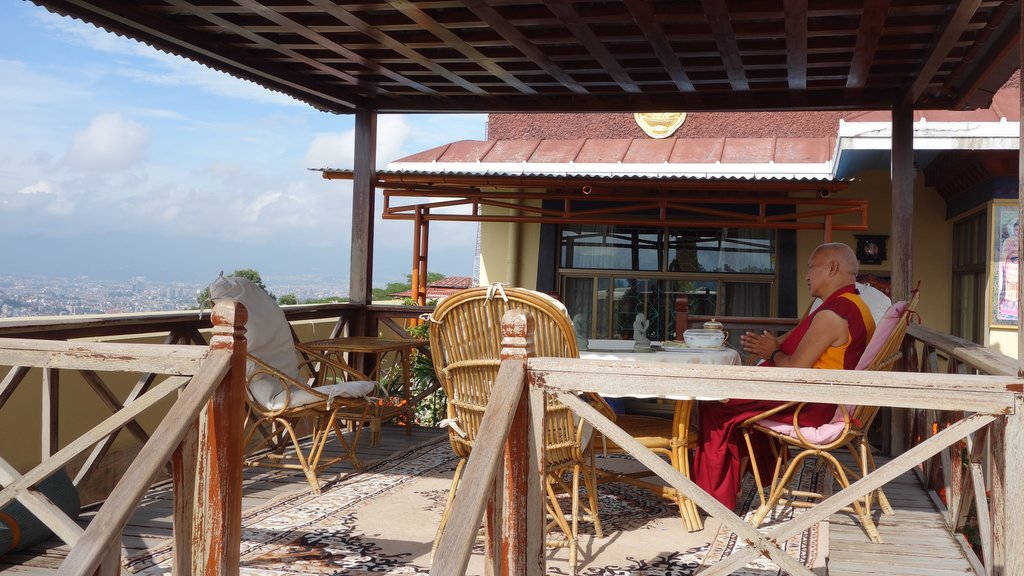
Lama Zopa Rinpoche doing morning prayers, Kopan Monastery, August 10, 2013. Photo by Ven. Roger Kunsang.
“Rinpoche this morning doing prayers before breakfast, with a view of the Kathmandu Valley (from Kopan ),” Ven. Roger wrote. “The valley is very green at the moment. … It’s monsoon and there has been plenty of rain.”
Meanwhile in Mongolia the 100 Million Mani Retreat is underway. Participants are looking forward to Rinpoche’s arrival. FPMT Mongolia organized the retreat, which is being held at Idgaa Choizinling Dratsang (College), Gandan Monastery, Ulaanbaatar, Mongolia, and which started on August 1. Rinpoche is guiding the retreat and is expected to arrive on August 13.
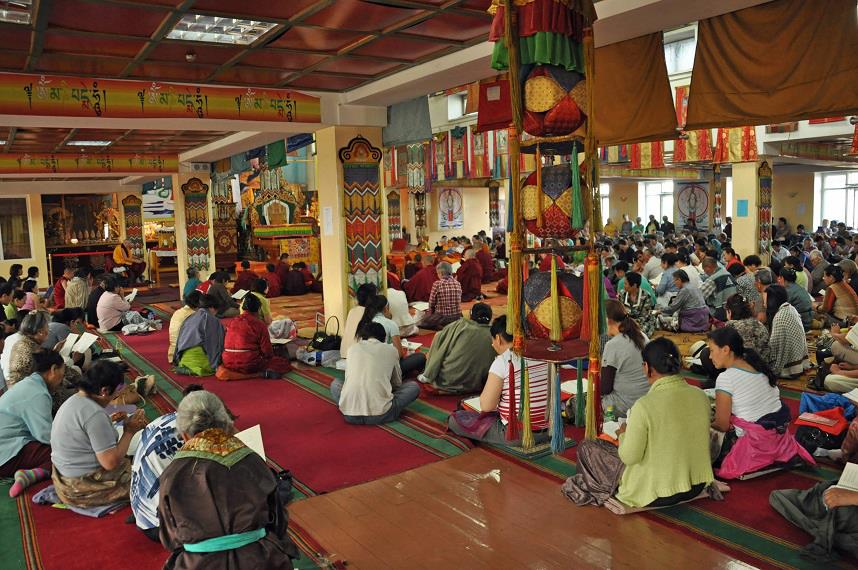
100 Million Mani Retreat, Ulaanbaatar, Mongolia, August 2013. Photo courtesy of FPMT Mongolia on Facebook.
Mandala brings you news of Lama Zopa Rinpoche and FPMT activities, teachers and events from over 160 FPMT centers, projects and services around the globe. If you have news you would like to share, please let us know.
- Tagged: 100 million mani retreat, fpmt mongolia, kopan monastery, lama zopa rinpoche, mandala, mongolia
- 0
7
Understanding Lam-rim: An Interview with Ven. Sangye Khadro on the Masters Program
Ven. Sangye Khadro (Kathleen McDonald), a senior American nun, is currently in the process of completing the seven-year Masters Program at Istituto Lama Tzong Khapa (ILTK) in Italy. Before entering the program, Ven. Khadro already had extensive teaching experience and had authored the book How to Meditate and appeared in the Discovering Buddhism DVD series. Mandala interviewed her over email in April 2013 about the Masters Program and the benefit of in-depth study.
Mandala: For our readers who are not familiar with your background, can you share a little about when you became Buddhist and your involvement with FPMT?
Ven. Sangye Khadro: I started studying Buddhism in 1973 at the Tibetan Library in Dharamsala, India. In early 1974, I went to Kopan Monastery in Nepal and continued to study there, and was ordained as a nun in May 1974. I stayed in Kopan for three years – living in the community of Western nuns and monks under the guidance of Lama Yeshe and Lama Zopa Rinpoche – then returned to the West. Since then I have lived, studied, taught and done retreat in various FPMT centers around the world.
Mandala: You had already established yourself as a teacher when you began the Masters Program at Istituto Lama Tzong Khapa (ILTK.) What influenced your decision to enter the program?
Ven. Sangye Khadro: I had the chance to study Buddhist philosophy for about four to five years while living in England and France in the early 1980s, and I really loved it, but then I became busy teaching in centers and did not have much time to continue my studies. Several years ago – I think it was 2005 – I was doing a longish retreat at O.Sel.Ling Centro de Retiros in Spain, and some of the students of the first Masters Program who had recently completed the program were doing retreat there at the same time. I felt so happy thinking about how they had spent the last six years of their lives doing intensive study of the great Buddhist classics, and now they were doing retreat to integrate what they had learned. I found it easy to rejoice! …
From Mandala July-September 2013
6
Buddhist Business Lessons to Share: Creating Right Livelihood

“Starfish on Oregon Coast,” based on a photo by Ivan McClellan; Flickr Creative Commons Attribution
Maitripa College board member and entrepreneur Mark Waller shares some Buddhist business lessons he’s acquired over several decades:
“I first found myself sitting in front of Chogyam Trungpa 45 years ago at one of his early seminars in New York. With that began five years of retreats; cleaning his house in Boulder, Colorado, U.S.; living in and around the Naropa community there; attending seminars of many descriptions and sitting and more sitting. And, occasionally cracking a text.
“Fairly quickly, the need to pay rent and put some food on the table had to strike a balance with my new bodhisattva path. Several years of sporadic entrepreneurial adventures intermingled with intense legal work as I developed a conscientious objector petition at the most intense period of the Vietnam War. When my CO status was granted (just about simultaneously with my receiving a high draft lottery number), I was out of excuses and needed to work on right livelihood while continuing to dance with the Dharma.
“… But life since then has taught me some business lessons that I want share:
“Lesson 1: If you’re really stuck, go sit until you are inspired or the phone rings.
“It was clearly time for a reboot and so I just sat and waited. Eventually a college acquaintance came along who was getting ready to complete a natural resource IPO in Canada. And then a year or so later, I was the president. (Over the next three decades, I’d be president of numerous other public companies and private ventures.)
“Lesson 2: It’s not always critical, wise or profitable to be early in an emerging field. Fast followers, however, often live to fight another day or become the heroes. Find a hot trend and become better at it. …”
From Mandala July-September 2013
5
Transformative Mindfulness Methods Offered as Distance Course
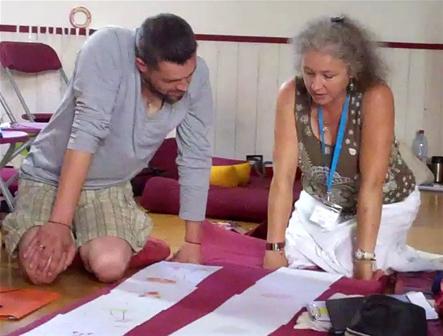
Students at the 2011 Universal Education gathering, Institut Vajra Yogini, France. Photo courtesy of Dekyi-Lee Oldershaw.
Starting August 19, Transformative Mindfulness Methods (TMM), a Universal Education for Compassion and Wisdom program, is offering a six-session distance course especially for FPMT and Foundation for Developing Compassion and Wisdom students, staff, monks and nuns. The distance course is called Discover Transformative Mindfulness Methods for Inquiry and Healing.
“Transformative Mindfulness includes a series of simple, natural healing methods and meditations that empower adults and youth to change their response to problems that plague them and strengthen positive qualities, deepening acceptance of themselves and compassion for others,” shares developer and FPMT student Dekyi-Lee Oldershaw.
“These methods can also draw on the power of the mind to help yourself and others to reduce or eliminate physical and mental pain. They assist in clarifying spiritual challenges associated with terminal illness and times of transition and deep questioning. These very simple but effective receptive visualizations, meditations and exercises can be coupled with drawing, writing or dialogue.”
The course is being given in celebration of a pair of courses to be offered in late 2013 and early 2014, both jointly certified by Transformative Mindfulness International and the Applied Mindfulness Meditation Certificate Program at the University of Toronto.
More information on Transformative Mindfulness Methods can be found online.
2

Lama Zopa Rinpoche giving advice to the cooks of Tushita Meditation Centre, Dharamsala, India, June 2013. Photo by Ven. Sarah Thresher.
During Lama Zopa Rinpoche’s most recent visit to Tushita Meditation Centre in Dharamsala, India, Rinpoche gave the following advice to the Tushita cooks:
I have been hearing from people that the food at Tushita is fantastic. Generally, they tell me they are very happy with the place and especially the food. I was amazed to hear this and particularly that you have been able to improve the flavor and quality of the food without using onions, garlic or other black foods. Of course, the initial reason why people come to Tushita is not the food, but for the teachings and meditations; they are a little bored with the lives they have and are looking for something new. However, the conditions at Tushita –and especially the food – are a very important support for the teachings and meditations. Sometimes in the past, for example, when I would teach on impermanence, the hells and the eight worldly dharmas, people would get scared and leave, but if the food was good, they would stay. That’s one way to keep them!
So I’ve been thinking for many days to come to the kitchen and explain a short meditation to the cooks. There is a short morning motivation I have put together with a direct meditation on the graduated path to the peerless happiness of full enlightenment. (Most of the time in English we use the expression “fully enlightened” but in Tibetan it is sang gye; sang means that all the obscurations, gross and subtle have been purified, and gye that all the realizations have been fully developed and there is nothing more to achieve. “Fully enlightened” has a different meaning; it’s better to say “fully omniscient mind.”) [This meditation is] followed by some verses explaining how precious and kind sentient beings are.
Every single sentient being is most precious, dear and wishfulfilling – fulfilling all your wishes for the happiness of future lives, liberation and enlightenment. Every hell being, hungry ghost, animal, insect, ant, mosquito, bird, goat, human being, sura and asura does this. That is because all our beginningless past lives’ happiness, present happiness and future happiness comes from good karma and that good karma comes from your mind, from mental intention. Buddha’s enlightened activity is of two types: one comes from Buddha’s holy mind and one from your mind. Buddhas come from bodhisattvas, bodhisattvas come from bodhichitta and bodhichitta comes from great compassion. Great compassion comes from every single obscured suffering sentient being. There is no way to generate great compassion without depending on every single suffering sentient being. Therefore, there is no bodhichitta, no bodhisattva, no Buddha and no way to create good karma, the cause of happiness, without them. In other words, every single happiness and comfort comes from sentient beings, even a cool breeze or a drink of water when you are thirsty. Without sentient beings there is no way to experience happiness in this life, future lives, liberation or enlightenment. All our happiness comes from every single sentient being.
For example, all my happiness comes from every one of you and from all the rest of the sentient beings; every hell being, hungry ghost, animal, human, sura and asura. All my past, present and future happiness comes from everyone because Buddha, Dharma and Sangha in whom I take refuge and with whom I purify every single negative karma and achieve the peerless happiness of full enlightenment come from everyone. That is why sentient beings are most kind, dear, precious and wishfulfilling.
Sentient beings are more precious than a wishfulfilling jewel because you can’t practice morality, purify negative karma and achieve a higher rebirth with a wishfulfilling jewel. Nor can you practice the three higher trainings and achieve the ultimate happiness of liberation or generate great compassion and achieve enlightenment with a wishgranting jewel, but you can with sentient beings. If you pray to a wishgranting jewel you can get a house, car, swimming pool and so on, but not higher rebirths, liberation and enlightenment. That’s why sentient beings are most unbelievably precious. Which one is more precious – skies of wishgranting jewels or sentient beings? Sentient beings are more precious!
Therefore, dedicating your life to others and helping them is the best, most exciting thing you can do. Serving them in any way you can and giving them whatever help you can give is what brings the most happiness. For example, helping an old man carrying a very heavy load or giving your seat to somebody in a bus, train or car. Doing whatever it is that sentient beings need, whether big or small, is the most satisfying, exciting thing you can do.
That’s why making delicious food and offering it to the people who come here is a really great opportunity. Wow, wow, wow, wow. It is a way of offering comfort and happiness to sentient beings who are most wishfulfilling. That’s what brings the most happiness and excitement. It’s the real Dharma. Dharma is something that protects your life, protects you from suffering and guides you to happiness….
There is a great deal to rejoice in that you have this very precious opportunity to offer food to sentient beings who are most precious, dear, kind and wishfulfilling.
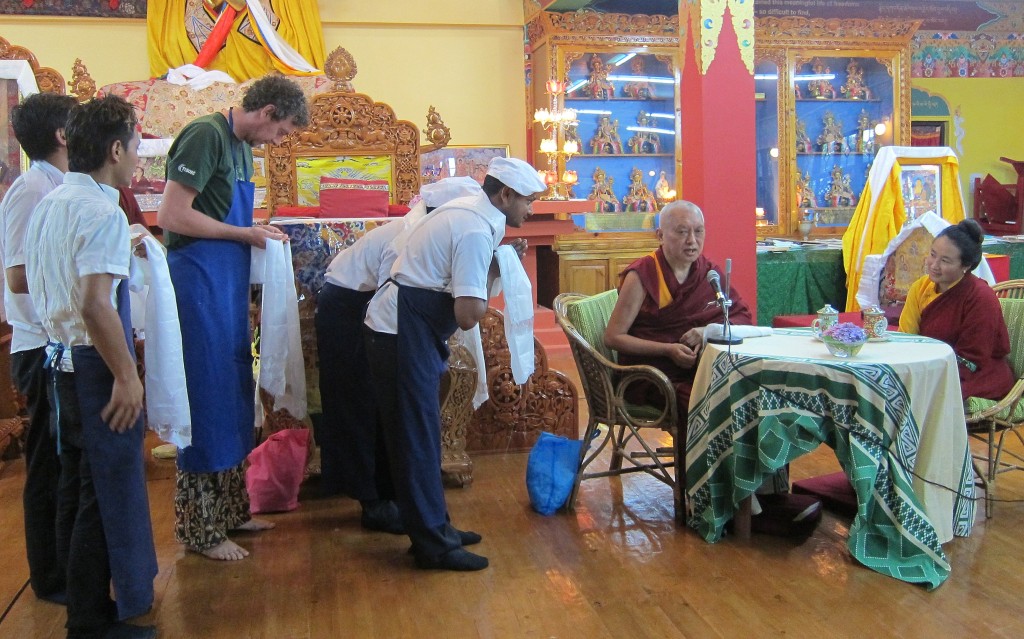
Lama Zopa Rinpoche and Khadro-la with Tushita Meditation Centre cooks, June 2013. Photo by Ven. Sarah Thresher.
Practicing bodhichitta mindfulness in the kitchen
Here are some ways to think while you are preparing and cooking the food:
When you are cutting anything, for example onions, think,
I am cutting the root of all sentient beings’ suffering which comes from ignorance and the self-cherishing thought, with the knife of the wisdom realizing emptiness (shunyata) and bodhichitta.
When you are washing pots and so on think,
I am washing away all the obscurations and negative karmas from all sentient beings’ minds.
You can think that you are washing away your own obscurations and negative karmas but most important is to think you are washing away those of all sentient beings. And you can think the water is nectar coming from Vajrasattva, the Guru, His Holiness the Dalai Lama, or Guru Shakyamuni Buddha. There is always a lot of washing up to do in the kitchen and you can use the opportunity to purify all sentient beings’ obscurations. It’s very good if you can sincerely think this way because all the washing up becomes Dharma practice purifying your negative karma and defilements and collecting merits. In India even the beggars keep their pots very clean!
When you are sweeping the floor think that the broom is the whole path to enlightenment, especially wisdom and bodhichitta, and that the dust is all sentient beings’ obscurations.
I am sweeping away the dust of all sentient beings’ obscurations with the broom of the path to enlightenment and especially wisdom and bodhichitta.
If you sincerely think this while you are cleaning it becomes real Dharma practice that benefits all sentient beings. In the lam-rim it says to think that you are abandoning the dust of the three poisonous minds – anger, attachment and ignorance – which are the gross obscurations and also the stains of the three poisonous minds, the subtle obscurations.
When you are kneading dough so that it can be made into any shape think,
I am taming all sentient beings’ minds by softening them with my two hands of the wisdom realizing emptiness and bodhichitta.
When you are making momos or shapale – rolling out pastry and filling it with cheese, potato and vegetables – think,
I am filling all sentient beings’ minds with the realizations of the path from guru devotion up to enlightenment so that they can actualize all the qualities of a buddha.
When you are cooking soup or other food you can think that the fire is the Six Yogas’ tummo fire that causes the kundalini to melt. Do the same meditation that is used to bless the inner offering in highest yoga tantra. Or you can think that the fire is the wisdom realizing emptiness and the uncooked food is the unsubdued mind. By cooking the food all the gross and even the subtle delusions are purified and all the realizations of Buddha are achieved.
These are some ways of thinking as you are working in the kitchen. You can think in a similar way with other kitchen activities.
Typed and edited by Ven. Sarah Thresher at Tushita Meditation Centre, Dharamsala, India, June 17, 2013.
Mandala brings you news of FPMT activities, teachers and events from over 160 FPMT centers, projects and services around the globe. If you have news you would like to share, please let us know.
- Tagged: cooking with bodhichitta, lama zopa rinpoche, mandala, teachings and advice, tushita meditation centre
- 0
1
Book Review: ‘A Classical Tibetan Reader’
By Yael Bentor; Reviewed by Donna Lynn Brown
Having the right selection of books available at each stage of learning is a challenge faced by students of classical Tibetan that is not shared by most students of European languages. While progress has been made toward meeting the needs of Tibetan language students, gaps still exist. With A Classical Tibetan Reader: Selections from Renowned Works with Custom Glossaries, Dr. Yael Bentor, a senior lecturer in Indian and Tibetan Studies at Hebrew University in Jerusalem, seeks to fill one of those gaps.
Dr. Bentor, who has taught classical Tibetan for 20 years, developed this textbook by compiling a series of short, enjoyable narratives alongside customized glossaries. This approach enables and encourages even beginners to read classical Tibetan, since the glossaries give each word’s meaning in the context of the narrative, which simplifies deciphering the story. Dr. Bentor herself teaches the alphabet and basic grammar before her students begin these readings, since a student cannot decode even the simplest sentence without them, but she does not teach grammar fully before plunging in. Instead, students learn grammar along with vocabulary as they work through the stories.
This method of instruction is more contextual and intuitive than that used when the full range of grammar is taught before introducing students to reading narratives. Learning styles vary, and for students who prefer to learn the finer points of “attributive syntax” and “the uses of declension” in the context of real Tibetan literature, rather than sentences in a grammar text, Dr. Bentor’s book provides a good balance of challenge and reward. It offers 12 readings of varying lengths, drawn from works that are already translated into English, and whose translations, while not appearing in this book, are easily available. Many of the readings will be familiar to Tibetan language students who have some background in Buddhism, such as short pieces from the life stories of Padmasambhava and Milarepa, and well-known Dharma teachings from Words of My Perfect Teacher like “The Faith of the Old Woman” and “Tuning the Vina.” Bentor’s teaching experience shows in her choice of stories that are fun to read and not overly difficult. She has avoided the complexities of philosophy and ritual, and stuck to selections from namthar [hagiography] and lam-rim that are ideal for novices. The book is not intended to go further, and Bentor recommends that students who complete it go on to the greater detail and subtlety found in readers based on philosophical texts. With one four-line exception, the book also contains no verse, a translation challenge that Bentor leaves for more advanced courses.
While made for the classroom, the Reader can be used outside of it by independent students, as long as they have a grammar text on hand, since Dr. Bentor’s book offers only the most minimal grammatical instruction. Given a good grammar text, though, those learning at home will likely find this reader first-rate. Even the intermediate student who wants to practice reading by spending some time with “ordinary” classical Tibetan, rather than philosophy or tantra, will benefit from this book. Indeed, for intermediate students who have studied grammar intensively but read relatively little, this textbook would be the ideal confidence-builder before tackling sadhanas or philosophical works. And for those able to read a little, this would be a good bedside book: not too serious, and with no need to consult a dictionary!
Dr. Bentor’s Reader is not intended to meet the language student’s every requirement. Rather, it fulfills a single need that has not, so far, been met very well: the need for enjoyable short narratives with matching glossaries that enable them to be deciphered even by novices. As such, it is a tremendously helpful tool for beginning, and even intermediate, students of classical Tibetan.
Donna Brown studies Tibetan language at Maitripa College in Portland, Oregon.
Published by Wisdom Publications
Paperback US$15.16
www.wisdompubs.org
- Tagged: book reviews, donna lynn brown, tibetan language
- 0
29
His Holiness the Dalai Lama Is Hopeful for the Future of Tibetan-Chinese Relations

His Holiness the Dalai Lama during a press conference in Portland, Oregon, U.S., May 11, 2013. Photo by Kurt Smith.
During His Holiness the Dalai Lama’s visit to Portland, Oregon, in May 2013, His Holiness spoke on the situation in China at a press conference. His Holiness told the media that while things have been very difficult for Tibetans, he is hopeful for the future.
His Holiness cites as an example how many mainland Chinese are now coming to see him in Dharamsala, India and that they are showing genuine interest in Tibetan Buddhism. In addition, His Holiness said there is growing recognition that censorship in China is ultimately self-destructive.
“1.3 billion Chinese people have every right to know the reality. Once they know reality, 1.3 billion Chinese people also have the ability to judge what’s right and what’s wrong,” His Holiness said. “So, censorship is morally wrong and very harmful. … Trust is the basis of harmony and unity. Censorship destroys that trust.”
His Holiness also called for improvement of the Chinese legal system, saying it must come up to the level of international legal standards.
You can listen to His Holiness’ complete response to the question of Tibet and China:
Audio recorded during the Dalai Lama Environmental Summit press conference in Portland, Oregon, May 11, 2013. (Audio available for download as an MP3.)
- Tagged: china, his holiness the dalai lama, mandala, tibet
- 0
26
On Becoming a Vegan: When Vegetarian is Not Enough
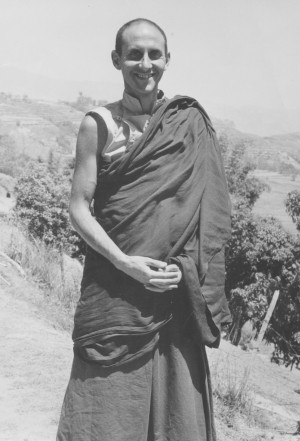
Nicholas Ribush, 1974. Photo courtesy of Nicholas Ribush.
Nicholas Ribush, a long-time FPMT student and director of Lama Yeshe Wisdom Archive writes on how he eventually became vegan:
“After my first Kopan meditation course (October-November 1972), I decided to stay on at the monastery and became a vegetarian by default, since meat was not on the general menu. Lama Zopa Rinpoche was a vegetarian and didn’t even eat eggs (“the seed of desire”). Lama Yeshe sometimes ate meat to sustain his body.
“In January 1974, most of Kopan went to Bodhgaya for the Kalachakra initiation and the ordination of 10 of us Westerners. Despite the bliss of it all, the physical conditions were far from ideal and I finished up with worms, ascaris lumbricoides, the giant roundworm. Yes. Giant.
“I lost a lot of weight and was pretty grumpy, but as a new monk, I didn’t want to kill the worms. ‘Rubbish,’ said Lama Yeshe. ‘Your life more benefit sentient beings than worms. Take medicine.’ So I did. He also told me to eat meat to regain my health and ordered the Kopan cooks to prepare it for me.
“Over the next two or three decades, I had an on-again-off-again relationship with vegetarianism, convincing myself with the usual arguments that eating meat was OK. The Buddha didn’t expressly forbid it; there were just three types of meat you should definitely not eat. Most Tibetan lamas ate meat; most of my many gurus did. You can bless and benefit the dead animal by reciting certain mantras over the meat. Even if you eat rice, dal and vegetables, many sentient beings die in the production of those foods. If you eat only large animals, where one can feed many people, it’s better than one person eating many small ones, like shrimp or poultry. …”
From Mandala July-September 2013
- Home
- News/Media
- Study & Practice
- About FPMT Education Services
- Latest News
- Programs
- New to Buddhism?
- Buddhist Mind Science: Activating Your Potential
- Heart Advice for Death and Dying
- Discovering Buddhism
- Living in the Path
- Exploring Buddhism
- FPMT Basic Program
- FPMT Masters Program
- FPMT In-Depth Meditation Training
- Maitripa College
- Lotsawa Rinchen Zangpo Translator Program
- Universal Education for Compassion & Wisdom
- Online Learning Center
- Prayers & Practice Materials
- Overview of Prayers & Practices
- Full Catalogue of Prayers & Practice Materials
- Explore Popular Topics
- Benefiting Animals
- Chenrezig Resources
- Death & Dying Resources
- Lama Chopa (Guru Puja)
- Lama Zopa Rinpoche: Compendium of Precious Instructions
- Lama Zopa Rinpoche: Life Practice Advice
- Lama Zopa Rinpoche Practice Series
- Lamrim Resources
- Mantras
- Prayer Book Updates
- Purification Practices
- Sutras
- Thought Transformation (Lojong)
- Audio Materials
- Dharma Dates – Tibetan Calendar
- Translation Services
- Publishing Services
- Teachings and Advice
- Find Teachings and Advice
- Lama Zopa Rinpoche Advice Page
- Lama Zopa Rinpoche: Compendium of Precious Instructions
- Lama Zopa Rinpoche Video Teachings
- ༧སྐྱབས་རྗེ་བཟོད་པ་རིན་པོ་ཆེ་མཆོག་ནས་སྩལ་བའི་བཀའ་སློབ་བརྙན་འཕྲིན།
- Podcasts
- Lama Yeshe Wisdom Archive
- Buddhism FAQ
- Dharma for Young People
- Resources on Holy Objects
- Ways to Offer Support
- Centers
- Affiliates Area
- Teachers
- Projects
- Charitable Projects
- Make a Donation
- Applying for Grants
- News about Projects
- Other Projects within FPMT
- Support International Office
- Projects Photo Galleries
- Give Where Most Needed
- FPMT
- Shop
Subscribe to FPMT News
Translate*
*powered by Google TranslateTranslation of pages on fpmt.org is performed by Google Translate, a third party service which FPMT has no control over. The service provides automated computer translations that are only an approximation of the websites' original content. The translations should not be considered exact and only used as a rough guide.Superficial observation of the sense world might lead you to believe that people’s problems are different, but if you check more deeply, you will see that fundamentally, they are the same. What makes people’s problems appear unique is their different interpretation of their experiences.







